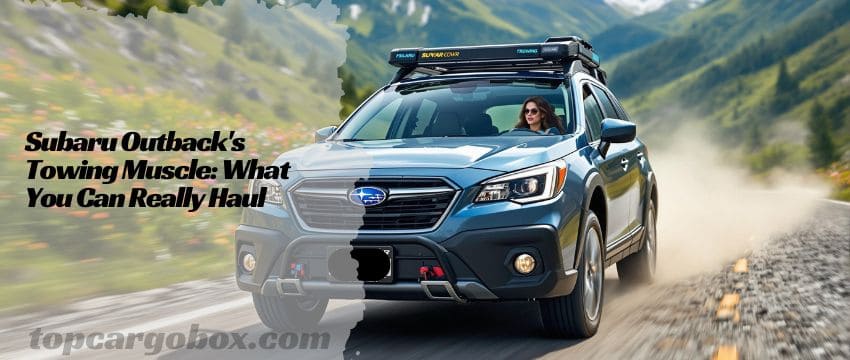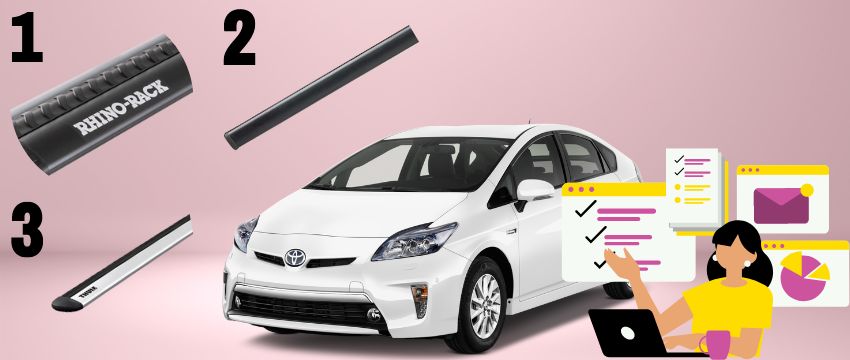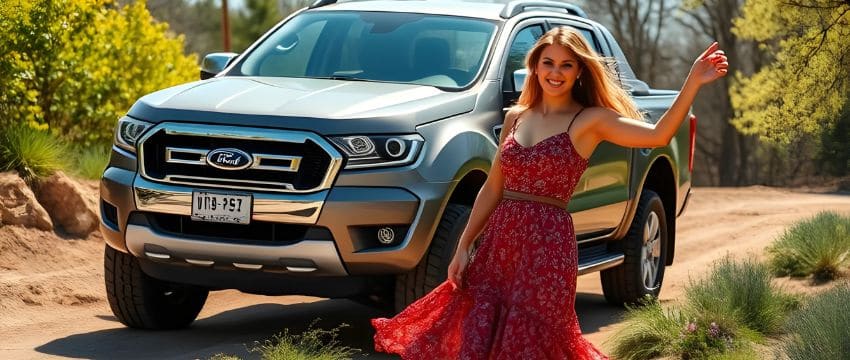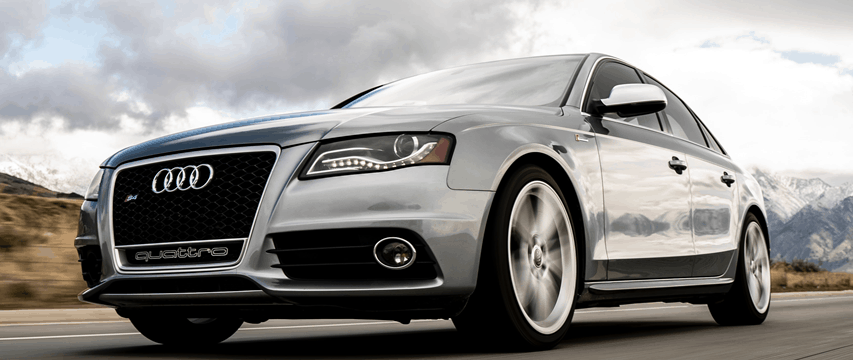What’s up, adventure seeker? So, you’ve got this awesome Subaru Outback sitting in your driveway. It’s taken you camping, hauled gear for countless DIY projects, and handled snowy roads like a champ. But now you’re eyeballing that camper trailer your buddy just bought, or maybe you need to tow a small boat for lake weekends. The big question hits you: “Can my Outback actually handle this?” Seriously, figuring out the real-world towing capacity feels trickier than assembling flat-pack furniture without instructions! Let’s cut through the marketing speak and get down to the actual facts about what your trusty wagon can pull.
For real? The official numbers only tell part of the story. It’s not just about hitting that max number plastered in the brochure. You’ve gotta think about the weight of your trailer, how it’s loaded, what gear you’ve packed inside the Outback itself, and even the kind of transmission humming under the hood. Overlook any of these, and you’re asking for trouble – from strained components to seriously scary handling on the highway. Trust me, nobody wants that white-knuckle feeling halfway up a mountain pass!
Quick-Pick List:
Hitch Model | Best For | Max Capacity | Receiver Size | Key Features | Check Price & Latest Info |
|---|---|---|---|---|---|
Draw-Tite 75673 Max-Frame | 2010-2019 Outback/Legacy owners needing max strength | 4,000 lbs GTW 600 lbs TW | 2-inch | Alloy steel, powder coated, no WDH | |
CURT 13494 | 2020-2025 Outback/Legacy owners wanting seamless install | 3,500 lbs GTW 350 lbs TW | 2-inch | Concealed design, co-cured finish | |
Draw-Tite 76227 | 2010-2019 Outback/Legacy heavy haulers | 4,000 lbs GTW 600 lbs TW | 2-inch | Identical to 75673, alternate part number | |
CURT 13390 | 2010-2019 Outback/Legacy owners needing WDH | 4,000 lbs GTW 600 lbs TW | 2-inch | Exposed design, WDH compatible | |
CURT 122703 (Class 2) | Older Outback/Legacy light-duty needs | 3,500 lbs GTW 350 lbs TW | 1.25-inch | Includes ball mount, budget option | |
CURT 13409 | Forester owners (verify year fit) | 3,500 lbs GTW 525 lbs TW | 2-inch | Forester-specific, co-cured finish |
Understanding the Official Numbers (It’s Not Just One Figure!)
How’s it going with deciphering specs? Let’s break down those key terms you absolutely need to know before hitching up anything. Think of these as the golden rules of towing safely with your Outback. Ignoring them is basically asking for a bad day, or worse.
Max Towing Capacity: The Big One (But Handle With Care!)
No way! This is the headline number everyone focuses on, usually sitting between 2,700 and 3,500 pounds depending on your specific Outback year and engine. Sounds decent, right? Totally, for smaller loads! But here’s the catch: this is the absolute maximum your vehicle is engineered to pull under ideal conditions. It assumes a perfectly balanced trailer, only the driver in the car (no passengers, no cargo!), ideal weather, and perfectly flat ground. Are you serious? Like that ever happens in real life! Hitting or exceeding this number constantly is pushing your Outback way too hard and can lead to premature wear or worse. Think of it as a ceiling you really don’t want to bump your head on.
Payload Capacity: Your Vehicle’s Weight Limit
Dude, this one sneaks up on people! Payload capacity is the total weight your Outback can carry inside itself. We’re talking passengers, dogs, camping gear stuffed in the back, that heavy cooler full of drinks, and the weight pressing down on the hitch from the trailer (tongue weight – more on that next!). You find this specific number on a yellow sticker inside your driver’s door jamb. It’s way easier to max this out than you think, especially when adding tongue weight. Overloading here makes your Outback feel sluggish, hurts braking, and stresses the suspension. Not a good look!
Tongue Weight: The Critical Downward Force
This is legit the most important detail most folks overlook. Tongue weight is the downward force the trailer’s coupler exerts directly onto your Outback’s hitch. For safe towing, it should be 10-15% of the trailer’s total loaded weight. So, a 2,000 pound trailer needs 200-300 pounds of tongue weight. Why does this matter so much? Too little tongue weight (less than 10%) makes the trailer unstable and prone to dangerous swaying. Too much tongue weight (over 15%) overloads your rear suspension, makes steering light and vague, and eats into your precious payload capacity. Getting this right is non-negotiable for control!
Let’s get real. Imagine loading that trailer with all the heavy stuff way at the back. The tongue weight drops, and suddenly your trailer starts fishtailing wildly behind you on the interstate. That’s crazy! Conversely, shoving everything right up front near the hitch overloads the rear tires and makes steering feel scary-light. Using a good tongue weight scale is a game-changer for safety. Don’t just guess!
Subaru Outback Towing Specs by Generation & Engine
Long time no see, those confusing model year changes! Subaru has tweaked the Outback’s towing abilities over the years, mainly influenced by the engine and transmission combo. Here’s a quick cheat sheet to see where yours likely stands:
Subaru Outback Towing Specifications Overview
Model Years | Engine | Max Towing Capacity | Typical Payload Capacity | Max Tongue Weight | Roof Load Limit |
2010-2014 | 2.5L 4-Cyl | 2,700 lbs | 900-1,100 lbs | 270 lbs | 150 lbs |
2010-2014 | 3.6L 6-Cyl | 3,000 lbs | 850-1,050 lbs | 300 lbs | 150 lbs |
2015-2019 | 2.5L 4-Cyl | 2,700 lbs | 900-1,100 lbs | 270 lbs | 150 lbs |
2015-2019 | 3.6L 6-Cyl | 2,700 lbs | 850-1,050 lbs | 270 lbs | 150 lbs |
2020-2024 | 2.5L 4-Cyl | 2,700 lbs | 900-1,100 lbs | 270 lbs | 150 lbs |
2020-2024 | 2.4L Turbo | 3,500 lbs | 850-1,050 lbs | 350 lbs | 150 lbs |
2025+ | 2.5L 4-Cyl | 2,700 lbs | ~1,000 lbs | 270 lbs | 150 lbs |
2025+ | 2.4L Turbo | 3,500 lbs | ~950 lbs | 350 lbs | 150 lbs |
Bummer alert! Notice the dip for the 3.6L models from 2015-2019? That was purely down to the transmission limitations at the time. Feeling under the weather about your older 6-cylinder’s lower rating? Totally get it! The turbocharged XT models are the clear towing champs of the modern Outback lineup, offering that extra 800 pounds of capacity. Awesome! Always, always double-check your specific year’s owner’s manual for the definitive numbers – don’t rely solely on this table!
The CVT Factor: A Key Limitation
Off the top of my head, the biggest game-changer for Outback towing was the switch to Continuously Variable Transmissions (CVTs) across the board. What’s the deal with CVTs and towing? Unlike traditional automatics with fixed gears, a CVT uses a belt and pulley system. While great for smoothness and fuel economy in daily driving, this design creates more heat and stress under heavy, sustained loads like towing. That’s why Subaru engineers had to be conservative with the ratings, especially on the non-turbo models. Pushing a CVT too hard while towing is a surefire way to shorten its lifespan significantly. No way around it!
What Can You Safely Tow With Your Outback?
Seriously, forget trying to hit that absolute max number. For stress-free adventures, aim for roughly 80% of your Outback’s rated capacity. This gives you a crucial safety buffer for real-world variables: unexpected hills, headwinds, higher temperatures, or slightly misjudging the load. Peace of mind? Totally worth it! So, what fits comfortably within this realistic zone?
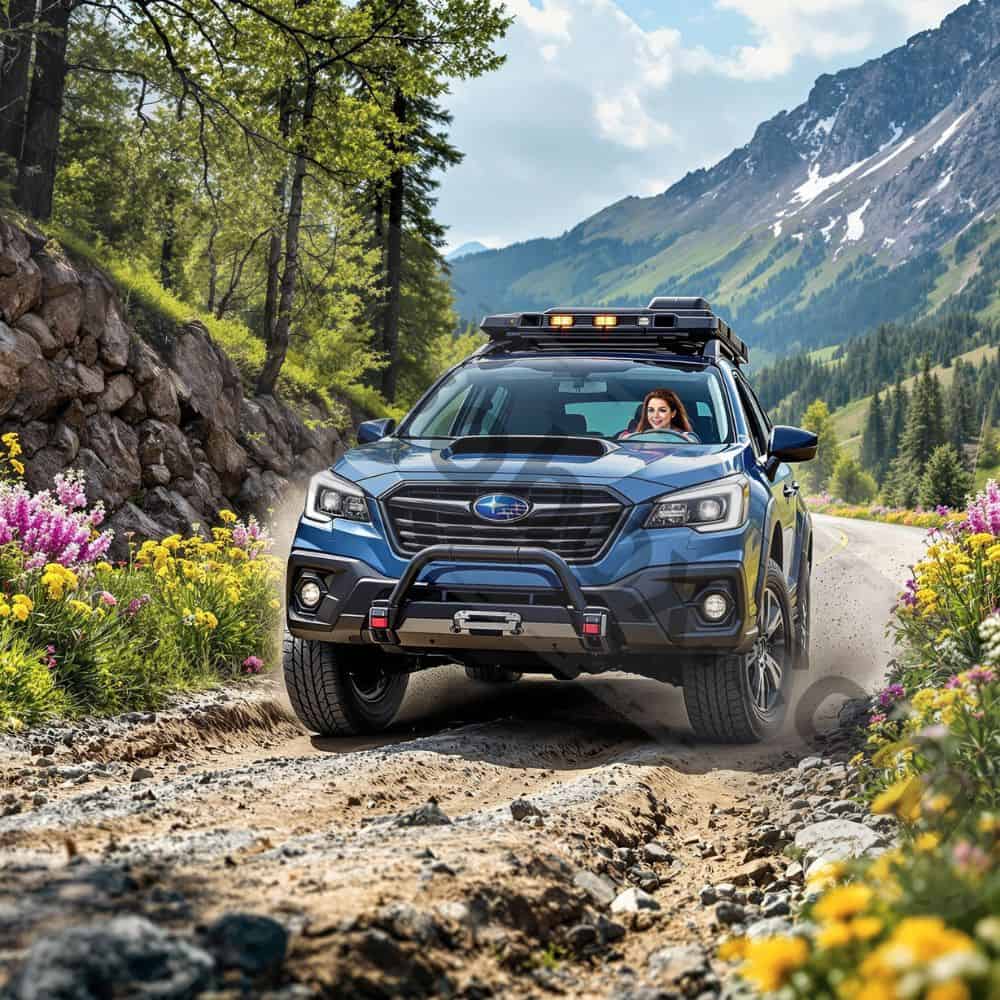
Lightweight Travel Trailers & Pop-ups
You good with camping? Compact, lightweight travel trailers and pop-up campers are legit the best match for the Outback’s capabilities, especially non-turbo models targeting that ~2,160 pound sweet spot (80% of 2,700). Focus on brands known for ultralight designs. Crucial tip: Pay obsessive attention to the trailer’s actual loaded weight (GVWR – Gross Vehicle Weight Rating), not just its dry weight (which never includes propane, batteries, water, or your gear!). That dry weight figure is basically useless! Always factor in 300-800 extra pounds for “camping stuff.”
Jet Skis, Small Boats & Personal Watercraft
Dude, summer fun! Towing a single PWC (jet ski) or a small aluminum fishing boat + trailer is usually no big deal for any Outback, often falling well under 1,500 pounds. Even two PWCs on a double trailer often stay comfortably below 2,200 pounds loaded. Key points: Ensure the trailer brakes (if required by weight/state) are functional, and secure that outboard motor properly! Saltwater exposure? Give me a break and rinse everything thoroughly afterwards to avoid corrosion nightmares. Check out tips for protecting your rear bumper during loading on our rear bumper cover guide.
Motorcycles & Dirt Bikes
Are you kidding me? Towing a single motorcycle or a couple of dirt bikes on an appropriate lightweight trailer is generally well within even the base Outback’s capacity. A single street bike + trailer might weigh 1,000-1,500 pounds. Dirt bikes are even lighter. Critical safety: Use high-quality tie-downs (ratchet straps!) attached to proper anchor points on the trailer, and secure the front wheels with chocks. Double-check everything before rolling out!
Utility Trailers & Landscape Loads
Need to haul mulch, gravel, or DIY supplies? A small, single-axle utility trailer (often 800-1,200 pounds empty) is a great Outback companion. Huge caution: It’s incredibly easy to overload these trailers with dense materials like gravel, sand, or pavers! Calculate the weight: A cubic yard of topsoil weighs roughly 2,000 pounds – that could max out a base Outback just with the trailer contents, not counting the trailer weight itself! Stick to lighter, bulkier materials and distribute the load evenly. Need more cargo space inside? Explore DIY cargo carrier mods safely.
What Should You Probably Avoid Towing?
Let’s be brutally honest. The Outback, while capable, isn’t a full-size truck or SUV. Some loads just push it too far, risking damage or unsafe conditions. Avoid these for safety’s sake:
Larger Travel Trailers & Fifth Wheels
For real? Most “average” travel trailers easily exceed 3,500 pounds dry, and quickly balloon past 4,500 or more loaded. Even the turbo Outback’s 3,500 pound limit is simply too low for these comfortably and safely. The length and wind resistance also create significant sway potential. That sucks, but it’s reality. Towing one would be stressful and potentially dangerous.
Heavier Boats (Even on Single Axle)
How’s it going with that 18-foot fiberglass bowrider? While the trailer might be single axle, the boat itself can easily weigh 2,500 pounds or more, plus the trailer (600-1,000 pounds), fuel, and gear. This quickly pushes beyond safe limits for non-turbo Outbacks and leaves minimal buffer even for turbos. The wind resistance of a tall boat is also a major factor. Not worth the risk!
Overloaded Utility Trailers
I get it, you want to get the job done in one trip. But piling heavy building materials (concrete bags, bricks, large quantities of rock/gravel) high on a utility trailer is a recipe for disaster with an Outback. You’ll likely: 1) Exceed max towing capacity, 2) Severely overload payload capacity via tongue weight, 3) Strain the transmission and brakes excessively. Make multiple trips or rent a truck. Need to maximize internal hauling instead? See which mattress sizes fit inside for camping.
Car Haulers (Even for Small Cars)
No way! Towing another vehicle, even a small one, requires a heavy-duty trailer. A small car like a Miata weighs ~2,400 pounds. A basic car hauler trailer weighs at least 1,600 pounds. That’s 4,000 pounds minimum, exceeding even the turbo Outback’s limit before adding any gear. Just don’t do it.
Essential Gear & Setup for Safe Outback Towing
Alright, so you’ve got a suitable load. Sweet! But just hooking it up isn’t enough. Using the right gear and setting things up correctly is crucial for safety and protecting your vehicle. Don’t skip this part!
Factory Tow Hitch vs. Aftermarket
Pretty good news: Many newer Outbacks can be ordered with a genuine Subaru tow hitch pre-installed at the factory. This is often the cleanest look and integrates well. No worries if yours didn’t come with one! High-quality aftermarket hitches (like Curt or Draw-Tite) are readily available and perform excellently. Crucially: Ensure it’s a Class III hitch (rated for 3,500 lbs / 350 lbs tongue weight) for turbo models or Class II (3,500 lbs / 350 lbs tongue weight is also common, but verify) for non-turbos. Avoid cheap, flimsy hitches! The receiver size (usually 1.25″ or 2″) must match your ball mount.
Weight Distribution Hitches (WDH) & Sway Control
Ever feel like the tail is wagging the dog? For trailers approaching 75% or more of your Outback’s max capacity, especially taller ones like pop-ups or small campers, a weight distribution hitch (WDH) is highly recommended. What does it do? It uses spring bars to redistribute some of the tongue weight forward to the front axle and back to the trailer axles. This helps:
- Restore front-end steering traction (no more scary light steering!).
- Level out the vehicle stance (prevents excessive rear sag).
- Reduce trailer sway dramatically.
Some WDH systems include integrated sway control, or you can add a separate friction sway control device. Worth every penny for stability and safety! Always follow the WDH manufacturer’s setup instructions precisely. Understanding your vehicle’s weight limits is key before using one.
Trailer Brake Controller (Mandatory Over Certain Weights)
Legally required in most states/provinces for trailers over 1,500 or 2,000 pounds gross weight (check your local laws!). How’s it going to stop that extra weight? Your Outback’s brakes aren’t designed to handle it alone. A trailer brake controller mounted inside your cabin sends an electronic signal to activate the trailer’s electric brakes when you press your brake pedal. This provides proportional braking force based on how hard you brake. Essential for safe stopping distances and preventing the trailer from pushing you. Choose a quality proportional controller (like Tekonsha Prodigy or Redarc) for the smoothest, safest braking.
Proper Hitch Ball & Wiring Harness
Sounds simple, but messing this up sucks! The hitch ball must match your trailer coupler size (usually 2″). Crucially: The ball’s weight rating (e.g., 6,000 lbs / 600 lbs tongue) must exceed your trailer’s loaded weight and tongue weight. Grease the ball! Use a locking pin. For wiring, you need a vehicle-specific wiring harness that plugs into your Outback’s taillight system. Ensure it’s wired correctly for brake lights, turn signals, and running lights. Test all lights every time before hitting the road! Consider window deflectors to keep airflow comfortable while towing.
Driving Tips While Towing with Your Outback
Hooked up and ready to roll? Hang tight! Towing changes everything about how your Outback drives. Adopting the right habits keeps you safe and reduces wear and tear. Listen up!
Acceleration, Braking & Following Distance
Forget the quick starts and zipping through traffic. Take it easy! Accelerate gradually to avoid excessive strain on the transmission and drivetrain. Anticipate stops way earlier – you need significantly more distance to brake safely. Increase your following distance to at least 5-6 seconds behind the vehicle in front, maybe more. Sudden maneuvers are a big no-no; plan lane changes well in advance and signal early. Downshift using the manual mode (if equipped) or paddle shifters on long descents to use engine braking and save your actual brakes from overheating. Your brakes will thank you!
Managing Sway & Crosswinds
Ever feel that unsettling wobble? If your trailer starts swaying, do NOT slam on the brakes! This often makes it worse. Instead:
- Firmly grip the steering wheel.
- Gently ease off the accelerator to slow down gradually.
- Consider using the manual trailer brake controller lever (if equipped) for a gentle tug only on the trailer brakes to help straighten it out.
Avoid overcorrecting with the steering. Large trucks passing you or strong crosswinds can trigger sway – be prepared! A properly set-up WDH and correct tongue weight are your best defenses. If you have a roof box, using the quietest cargo box helps reduce wind noise adding to stress.
Monitoring Gauges & Taking Breaks
Keep a close eye on your engine coolant temperature and transmission fluid temperature gauges (if equipped). Towing, especially in heat or up grades, pushes these systems hard. If you see temps climbing significantly above normal, it’s time to pull over safely and let things cool down. I’m beat just thinking about it, but plan to take breaks every 1-2 hours. It gives you and your Outback a rest, allows you to check trailer tie-downs, lights, and tire pressures (both vehicle and trailer!), and ensure everything is still secure. Preventative checks are way better than roadside repairs!
Alternatives When Towing Isn’t the Answer
Sometimes, the load is just too big or heavy. Bummer! But don’t despair; your versatile Outback still has tricks up its sleeve. Check out these legit alternatives:
Maximizing Roof Rack Capacity
What’s up, roof? Your Outback’s roof rails (crossbars needed!) can handle up to 150 pounds of evenly distributed cargo. That’s awesome for bulky but relatively light items: kayaks, stand-up paddleboards, roof boxes full of camping gear, or even a cargo basket. Key advantages: Keeps your interior free for passengers/dogs and doesn’t impact payload as severely as tongue weight. Disadvantages: Increases wind noise and fuel consumption significantly (aerodynamics suck!), and loading heavy items up high can be awkward. Need the best racks? We’ve got you covered with the top roof racks for your Outback and the best rooftop carriers. Be mindful of how a roof basket impacts fuel economy.
Utilizing Hitch-Mounted Cargo Carriers
No way! You can get a platform that plugs right into your hitch receiver. These carriers typically hold 150-500 pounds. Perfect for bulky coolers, storage bins, firewood, or dirty items like grills or muddy boots that you don’t want inside. Major benefit: The weight sits lower than roof cargo, so less impact on handling and center of gravity. Crucial reminder: The weight on the carrier counts directly against your payload capacity and tongue weight limit, even without a trailer! Don’t overload it. Explore affordable cargo solutions too.
Good Old-Fashioned Packing Smart Inside
Old school, but effective! Before resorting to towing or external carriers, really scrutinize what you need to bring. Pack strategically, utilizing every nook and cranny efficiently. Use soft bags that mold into spaces better than hard suitcases. Consider a quality rear seat cover to protect seats when folding them down for more gear space. Sometimes, just packing smarter eliminates the need for extra hauling capacity altogether. How wonderful is that?
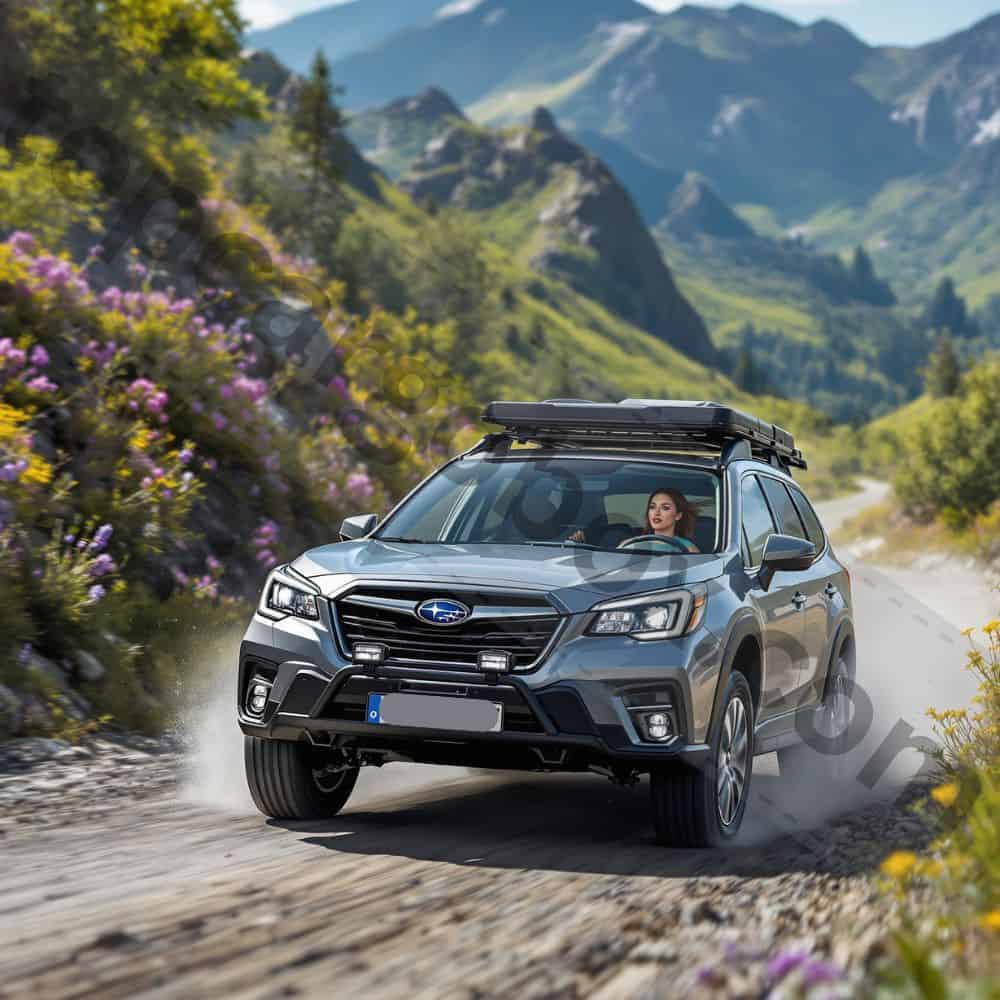
Key Takeaways: Towing Smart with Your Subaru Outback
Let’s hang out with the facts one last time. Your Outback is a surprisingly capable hauler within its well-defined limits. Respect the 2,700 or 3,500 pound max towing capacity, but realistically aim for 80% of that number. Never, ever forget the critical importance of 10-15% tongue weight and how it eats into your payload capacity (check that door jamb sticker!). The CVT transmission demands respect – avoid overheating it with excessive loads or steep, sustained climbs.
Invest in the right gear: a proper hitch, potentially a WDH for heavier trailers, and absolutely a brake controller for trailers over 1,500-2,000 pounds. Drive defensively, anticipate everything, and take breaks. If the load feels too big, it probably is. Use your roof or a hitch carrier for bulky items instead, or pack smarter inside. Knowing your Outback’s real capabilities means more adventures, less stress, and keeping your trusty wagon running strong for years to come. Catch you later on the open road – safely loaded, of course! Looking for a reliable used Outback for towing? Check our guide on the most reliable Outback years.
Your Outback’s Missing Muscle: Unpacking the Draw-Tite 76209 Hitch
What’s up, Subaru adventurer? Feeling that pang of envy watching buddies hook up trailers or bike racks while your Outback’s rear end looks… naked? Totally get it. Maybe you scored a sweet deal on a used Outback that didn’t come with a factory hitch. Or perhaps you’re eyeing a small camper and realizing you need legit towing power. That’s awesome you’re looking at the Draw-Tite 76209! But let’s cut through the specs and marketing fluff. Is this Class 3 hitch the real deal for your 2010-2019 Outback or Legacy? Buckle up, we’re diving deep into what makes this hunk of steel tick, where it shines, and what you really need to know before hitting “Add to Cart”.

Why Settle for Less? The Case for a Proper Hitch
How’s it going with those factory limitations? No way is the flimsy plastic bumper cover meant for actual hauling! Trying to jerry-rig a cheap hitch or overloading your roof rack sucks – trust me, the wind noise alone will drive you nuts. What if you could add serious towing grunt and keep your adventure gear secure? The Draw-Tite 76209 promises exactly that: a 2-inch square receiver built like a tank, rated for 4,000 pounds of trailer pulling power and 600 pounds pushing down on the tongue. That’s legit peace of mind when you’re hauling a loaded utility trailer or your beloved boat. For real, isn’t it time your Outback lived up to its full potential?
Built Tough: Materials & Construction That Matter
Off the top of my head, you’re probably wondering, “Will this thing rust out in a year?” Relax, dude. Draw-Tite doesn’t mess around. The 76209 is forged from solid alloy steel – none of that flimsy tubular stuff that bends under pressure. Every weld is critical, and they’re all done robotically for consistent, rock-solid strength. Then comes the armor: a two-stage finish starting with a corrosion-fighting E-coat primer, topped with a durable black powder coat. This isn’t just paint; it’s a shield against road salt, gravel chips, and weather. Sure, it’s not indestructible (deep scratches need touch-up!), but it’s built to last way longer than your loan payments.
Designed to Fit: No Guesswork Installation
Ever wrestled with a “universal” hitch that needed a grinder and a prayer? Give me a break. The beauty of the Draw-Tite 76209 is its vehicle-specific design. Engineers literally modeled it on Subaru’s blueprints for the 2010-2019 Outback and Legacy. That means:
- Clean Look: Tucks up neatly under the bumper, minimizing ground clearance loss.
- No Drilling (Usually!): Uses the factory pre-tapped frame holes –
90%of installations are bolt-on. - No Bumper Cutting: Fits perfectly behind the bumper cover on most model years.
Seriously, isn’t it refreshing when something just fits? You might need to trim a tiny bit of the lower bumper fascia on some later models, but it’s usually minor. Check your specific year on the Draw-Tite fit guide or forums before sweating it. Protecting your bumper during install or cargo loading? Our rear bumper cover guide has your back.
| Draw-Tite 76209 Key Specs At A Glance | |
|---|---|
| Receiver Size | 2-inch Square |
| Max Towing Capacity | 4,000 lbs Gross Trailer Weight (GTW) |
| Max Tongue Weight | 600 lbs (TW) |
| Construction | Solid Alloy Steel, Full Welds |
| Finish | E-Coat Primer + Black Powder Coat |
| Weight Distribution Compatible? | No |
| Warranty | Nationwide Lifetime Limited Warranty |
| Included | Hitch, All Mounting Hardware, Receiver Pin & Clip |
| Vehicle Fit | 2010-2019 Subaru Outback, 2010-2019 Subaru Legacy |
Beyond Towing: Unleashing Your Outback’s Cargo Potential
Think this hitch is just for trailers? Nah, bro! That’s only half the story. That 2-inch receiver is a magic portal to so much extra space. Struggling to fit bikes inside without greasing up your seats? Bummer. Slap on a quality bike rack – suddenly, you’re carrying 2-4 bikes easily, keeping the interior free for passengers and dogs. Check out the best bike racks for your Outback that plug right in. Overwhelmed by camping gear? A hitch-mounted cargo carrier adds 150-500 pounds of extra hauling down low, perfect for coolers, firewood, or muddy boots. Way better than wrestling stuff onto the roof! Explore affordable cargo solutions or DIY mods for your carrier.
What Can You Really Tow Safely?
Hold up! Just because the hitch says 4,000 lbs doesn’t mean your Outback can handle that! Remember our chat about your Outback’s actual limits? Totally crucial. The 2010-2019 Outback’s max towing capacity is only 2,700 lbs (non-turbo) or 3,500 lbs (2019+ 3.6L or 2020+ Turbo XT). Never exceed your vehicle’s rating! The Draw-Tite 76209’s higher rating simply means it’s overbuilt for safety within your Outback’s limits. Perfect for:
- Small Campers/Pop-ups: Aiming for
1,800–2,500lbs loaded? You’re golden. - Jet Skis & Small Boats: Usually well under
2,000lbs. - Motorcycles/Dirt Bikes: Easily handled.
- Utility Trailers: Haul mulch, lumber, or gear confidently.
Crucial Reminder: This hitch cannot be used with Weight Distribution Hitches (WDH). If your trailer pushes past75%of your Outback’s max capacity (~2,025lbs for base,~2,625lbs for turbo), you need a different hitch solution. Understanding your Outback’s weight limits is essential.
Getting It On: Installation Real Talk
Feeling intimidated by the install? Hang tight! How’s it going with basic tools and a free afternoon? For many DIYers, it’s totally doable. The kit comes with everything – bolts, nuts, washers, even the receiver pin and clip. No hunting for parts! You’ll likely need:
- Floor Jack & Jack Stands: Non-negotiable for safety.
- Socket Wrench Set: Usually
13mm,15mm, and17mmsockets. - Torque Wrench: Absolutely essential to tighten bolts to spec (
~70 ft-lbs, check manual!). - Wire Coat Hanger/Punch: To help align frame holes.
- Penetrating Oil: If your Outback’s seen winter roads, spray bolts beforehand!
The gist: Support the vehicle securely, remove the rear muffler hangers (temporarily!), maneuver the hitch into place (it’s37lbs – manageable!), align bolts, torque everything down. Plenty of detailed YouTube guides exist for your exact year! Not feeling it? Fair enough – a shop can usually install it for$150-$300.
The Draw-Tite Difference: Why Brand Reputation Counts
Who knew hitches had pedigrees? Draw-Tite’s been the real deal since 1946 – that’s older than most of our dads! They didn’t become “North America’s Favorite Hitch” by cutting corners. Every 76209 undergoes brutal testing – fatigue tests, stress tests – far beyond industry standards (exceeding SAE J684 and V-5). That lifetime limited warranty? That’s them betting their steel won’t let you down. It’s peace of mind knowing your gear, trailer, and family are secured by decades of engineering. Choosing a reliable hitch is like choosing a reliable Outback year – it pays off long-term.
Living With the Draw-Tite 76209: The Good & The Nitty-Gritty
Alright, it’s bolted on. Now what? How’s it going daily driving? Mostly, you’ll forget it’s there. Ground clearance loss is minimal. The powder coat holds up well against road grime with basic rinses. The slight increase in rear stiffness? Actually nice when you’ve got a heavy tongue load – less sag! The only real downside? A very minor potential for extra rear suspension noise on harsh bumps (some report a faint “clunk” – often fixed by re-checking torque). Small price to pay for serious capability! Need quiet roof options too? Consider the quietest cargo boxes.
Is the Draw-Tite 76209 Your Outback’s Missing Link?
Let’s hang out with the final verdict. If you own a 2010-2019 Outback or Legacy and need:
- Real towing muscle (within your vehicle’s limits!).
- A bombproof platform for bike racks or cargo carriers.
- Factory-level fit without bumper butchery.
- Unshakeable durability backed by a lifetime warranty.
Then heck yeah, the Draw-Tite 76209 is a stellar choice. It solves the “naked bumper” problem with industrial strength and smart design. Just remember: Respect your Outback’s 2,700 or 3,500 lb limit, skip the weight distribution hitches, and torque those bolts! For the price and performance, it’s hard to beat. Catch you later on the road, finally hauling that camper or bikes with confidence! Considering a new Outback? Get buyer’s advice here.
Your Draw-Tite 76209 Hitch Questions Answered
You good? Got specifics buzzing in your brain after all that? No worries, let’s tackle the common ones head-on. Hit me up below if you’ve got more!
Is it resistant to rust?
Absolutely, that’s a major highlight! The Draw-Tite 76209 isn’t just painted; it gets a serious two-stage defense system. First, it’s dipped in an E-coat primer – this stuff electrically bonds to the steel to fight corrosion from the inside out. Then, it’s finished with a tough black powder coat that’s baked on, creating a hard, uniform shell much more resilient than regular spray paint. Will it last forever in salty winter hell? Probably not indefinitely without some care, but it’s leagues better than cheap, thinly painted hitches. Routine rinses after exposure to salt or mud go a long way, and touching up any deep scratches with matching paint keeps it protected. For the average user, rust won’t be an issue for many, many years.
Does it require professional installation?
Not necessarily! If you’re reasonably handy and have the right tools, installing the Draw-Tite 76209 yourself is totally achievable and a great way to save some cash. The kit includes all necessary hardware, and it bolts directly into your Outback/Legacy’s pre-existing frame holes in most cases. Crucially, you NEED: a safe way to support the vehicle (jack stands!), the correct socket sizes, and most importantly, a torque wrench to tighten bolts to the exact specification. If the thought of crawling under your car or torqueing critical bolts makes you sweat, or if your area uses heavy road salt (making bolts stubborn), paying a pro $150-$300 is smart money. They’ll have it done fast and know any model-specific tricks.
What tools are needed for installation?
Off the top of my head, here’s your DIY toolkit: A floor jack and at least two jack stands (safety first, dude!). A full socket wrench set – you’ll primarily need 13mm, 15mm, and 17mm sockets and likely a 3/8-inch drive ratchet. The absolute must-have is a torque wrench capable of 70-100 ft-lbs – tightening to spec prevents issues. Helpful extras: Penetrating oil (like PB Blaster) for stubborn bolts, a punch or stiff wire (coat hanger works) to align frame holes, gloves, and safety glasses. Having a friend to help maneuver the hitch (37 lbs can be awkward!) is also a big plus.
What do customers say?
The feedback is overwhelmingly positive, for real! Owners constantly rave about the perfect fit – it bolts right up like it was meant to be there. The solid construction and lack of bumper cutting needed are huge pluses. Many DIYers express surprise at how straightforward the install was with basic tools. The powder coat finish generally gets thumbs up for durability. Are there gripes? A few mention potential for slight rear suspension noise (often fixed by re-torquing) or needing a little bumper trim on specific model years (check your fit!). The minor negatives are vastly outweighed by praise for its strength, value, and hassle-free fitment.
Does it come with a receiver pin?
Yes! Totally awesome, right? Draw-Tite includes everything you need to get hitched up right out of the box. This includes the hitch itself, all the specific bolts, nuts, and washers for your Outback/Legacy, AND a sturdy receiver pin with a locking clip (also called an R-clip or hairpin clip). No last-minute runs to the hardware store because you forgot the pin. Just slide it through your ball mount or accessory stem, pop the clip on, and you’re secure. One less thing to worry about!
Can it be used with bike racks?
Heck yes, that’s one of its best features! That 2-inch square receiver tube is the universal gateway to a ton of awesome accessories, and bike racks are probably the most popular. Whether you need a platform rack for 2 bikes or a hanging style for 4, as long as it has a 2-inch shank, it’ll plug straight into your Draw-Tite 76209. This is a game-changer for keeping your interior clean and freeing up space for people and gear. Ditch the roof-top bike wrestling match – hitching bikes at the rear is way easier and often more stable. Find the perfect one in our top bike racks guide. Just ensure your rack + bikes don’t exceed the 600 lb tongue weight limit (they almost never will!).
Hitching Up Your Subaru: Which Heavy-Duty Receiver Reigns Supreme?
What’s up, Subaru adventurer? Staring at a jungle of hitch models and feeling totally overwhelmed? I get it – specs blur together, brands promise the world, and nobody tells you which one actually fits your life (and your driveway projects). Let’s cut the noise and pit the heavyweights head-to-head: Draw-Tite 75673 Max-Frame, CURT 13494, Draw-Tite 76227, CURT 13390, and the wildcard CURT 122703 Class 2. No fluff, no jargon – just straight talk on who wins for your Outback, Legacy, or Forester.
The Core Contenders: Muscle vs. Integration
How’s it going with raw strength versus seamless style? Here’s the grunt lineup:
- Draw-Tite 75673 Max-Frame: The
4,000lb GTW /600lb TW brute (Fits 2010-2019 Outback/Legacy). - CURT 13494: The
3,500lb GTW /350lb TW sleek integrator (Fits *2020-2025* Outback/Legacy). - Draw-Tite 76227: Nearly identical twin to the 75673 (
4,000/600lbs) for 2010-2019 Outbacks. - CURT 13390: The exposed
4,000lb GTW /600lb TW beast (Fits 2010-2019 Outback/Legacy). - CURT 122703 Class 2: The lightweight (
3,500GTW /350TW) with a1.25-inchreceiver and included ball mount (Fits older Outback/Legacy).
See the split? It’s not just about pounds – it’s generation wars and philosophy. Draw-Tite throws down max steel muscle. CURT balances strength with OEM-level stealth (on newer models).
Material & Build: Rust Wars & Weld Integrity
Off the top of my head, you’re thinking, “Will this rust into dust?” Totally legit fear.
- Draw-Tite (75673 & 76227): Alloy steel construction. Robotic full-welds. Two-stage armor: E-coat primer + black powder coat. Feels like a tank. Lifetime warranty backs the brawn. Downside? Slightly heavier (
37lbs). Potential for faint suspension noise if bolts loosen over time. - CURT (All Models): Carbon steel. Uses “co-cured” magic: Submerged in liquid A-coat (Bonderite) inside and out, then topped with gloss powder coat. Unbeatable rust defense – especially in salt belts. Mix of robotic + manual welding. Lifetime warranty too. Lighter (
~35** lbs).**
Verdict? CURT’s co-curing gives a slight edge for corrosion prevention, especially in hidden crevices. Draw-Tite’s alloy steel feels denser. Both are leagues beyond cheap painted hitches.
Installation Reality: Bolt-On Bliss or Bumper Butchery?
Ever cursed “universal fit” hitches? Give me a break. Factory holes are gold.
- Draw-Tite 75673/76227 (2010-2019): Direct bolt-on using factory frame points. Zero bumper cutting on most years.
37lbs – manageable with a jack. Hardware included. - CURT 13494 (2020-2025): King of stealth. Tucks behind the bumper cover. Zero cutting required. Uses factory holes. Easiest DIY of the bunch for newer models.
- CURT 13390 (2010-2019): Exposed design (sits below bumper). Bolts to factory points. Might require minor plastic trim on some Outbacks. Still straightforward.
- CURT 122703 (Class 2, Older): Simple bolt-on. Lightest (
~30lbs?). Includes ball mount – nice bonus!
Harsh Truth: If you own a 2020+ Outback/Legacy, the CURT 13494 is the ONLY seamless, no-cut option. Older gens? Draw-Tite or CURT 13390 both work fine.
Capacity & Function: Beyond the Brochure Numbers
Are you serious? Just matching GTW isn’t enough. Here’s the real deal:
- Tongue Weight (TW) King: Draw-Tite 75673/76227 & CURT 13390 (ALL
600lbs TW). Essential for heavy cargo carriers, large bike racks (4-bikes + gear), or trailers needing10-15%tongue weight. Maxes out what your Subaru can handle. - The
350lb Compromise: CURT 13494 (350lbs TW). Limits you with heavy hitch accessories. A loaded4-bike platform rack + bikes can push250lbs+. Add a cargo carrier? Easy to hit350. Fine for lighter setups. - Class 2 Reality (CURT 122703):
1.25-inchreceiver.350lb TW. Forget heavy trailers or big cargo carriers. Best for: 1-2 bike racks, small cargo trays, ultra-light trailers. Cheaper, but limited growth.
Weight Distribution (WDH) Compatibility:
- Draw-Tite (75673/76227): NO WDH ALLOWED. Period.
- CURT 13390: YES! Can use WDH systems (crucial for trailers near
2,500+ lbs on older Outbacks). - CURT 13494/122703: Not designed for WDH.
Bike Racks & Accessories:
2-inchReceivers (All EXCEPT 122703): Vast accessory ecosystem. Platform bike racks, large cargo carriers. CURT explicitly blocks VERTICAL hanging racks (frame contact risk).1.25-inch(CURT 122703): Limited accessory choices. Often requires adapters. Not future-proof.
Who Wins Your Subaru? The Model-by-Model Breakdown
For 2010-2019 Outback/Legacy Owners:
- Need MAX Muscle & Accessory Flexibility?
Draw-Tite 75673/76227. That600lb tongue weight is gold for serious gear haulers. Disadvantage? No WDH option. Potential for minor noise. - Towing Near Vehicle Limit (
2,700lbs) & Want WDH?
CURT 13390.600lb TW + WDH compatibility = safer, stabier heavy tows. Disadvantage? Slightly more visible (exposed), possible minor trimming. - Just Bikes/Light Gear, Budget Conscious?
CURT 122703 (Class 2). Gets the job done cheaply. Disadvantage?1.25-inchreceiver severely limits future upgrades. Low tongue weight.
For 2020-2025 Outback/Legacy Owners:
- The ONLY Seamless Choice:
CURT 13494. Flawless integration. Zero cutting. Looks factory. Disadvantage?350lb tongue weight bottlenecks heavy accessories. No WDH.
For Forester Owners (Check Year!):
- CURT 13409 (
3,500GTW /525TW): Similar stealth goals as 13494.525lb TW is a decent bump over the Outback-specific CURT 13494. Verify exact model year fit!
The Final Verdict: Matching Hitch to Mission
Let’s hang out with the cold, hard truth:
- 2020+ Outback/Legacy: CURT 13494 is your mandatory pick for clean looks. Accept the
350lb TW limit or don’t tow/haul heavy. - 2010-2019 Outback/Legacy Heavy Haulers (Bikes/Gear): Draw-Tite 75673/76227. That
600lb TW is priceless for loaded racks/carriers. - 2010-2019 Owners Towing
2,000+ lbs: CURT 13390. WDH compatibility is a non-negotiable safety advantage for stable towing near your Outback’s max. - Light-Duty Users (Older Models): CURT 122703 saves cash if you only need bikes or tiny trailers. Know its limits.
- Forester Fans: CURT 13409 – get that
525lb TW if it fits your year.
Don’t gamble with cheap knockoffs. Draw-Tite and CURT are legit titans for a reason – lifetime warranties, rigorous testing (SAE J684/V-5), and engineering that respects your Subaru’s limits. Choose based on your year, your tongue weight needs, and whether WDH matters for your trailer dreams. Now go hook up and haul right!
Still stressed? Protect your investment with a tough rear bumper cover and understand your Outback’s true weight limits. Adventure awaits!
Here’s a detailed comparison of these six trailer hitches split across two tables for easier reading:
Heavy-Duty Hitches Comparison (Draw-Tite 75673/76227 vs CURT 13390 vs CURT 13494)
Feature | Draw-Tite 75673/76227 | CURT 13390 | CURT 13494 |
|---|---|---|---|
Compatible Models | 2010-2019 Outback/Legacy | 2010-2019 Outback/Legacy | 2020-2025 Outback/Legacy |
Max Towing Capacity | 4,000 lbs GTW | 4,000 lbs GTW | 3,500 lbs GTW |
Tongue Weight Limit | 600 lbs | 600 lbs | 350 lbs |
Receiver Size | 2-inch square | 2-inch square | 2-inch square |
Weight Distribution (WDH) Compatible? | No | Yes | No |
Construction Material | Alloy steel | Carbon steel | Carbon steel |
Finish | Two-stage (E-coat + powder coat) | Co-cured (A-coat + powder coat) | Co-cured (A-coat + powder coat) |
Installation | Bolt-on, no bumper cutting | Bolt-on, minor trimming possible | Fully concealed, no cutting |
Bike Rack Compatibility | 2″ racks (no vertical hanging) | 2″ racks (no vertical hanging) | 2″ racks (no vertical hanging) |
Best For | Max towing & cargo capacity | Heavy towing with WDH | Factory-style hidden hitch |
Light-Duty & Alternative Hitches Comparison (CURT 122703 vs CURT 13409 vs Draw-Tite 76227 Alternative)
Feature | CURT 122703 (Class 2) | CURT 13409 (Forester) | Draw-Tite 76227 (Alternative to 75673) |
|---|---|---|---|
Compatible Models | Older Outback/Legacy | 2019+ Subaru Forester | 2010-2019 Outback/Legacy |
Max Towing Capacity | 3,500 lbs GTW | 3,500 lbs GTW | 4,000 lbs GTW |
Tongue Weight Limit | 350 lbs | 525 lbs | 600 lbs |
Receiver Size | 1.25-inch | 2-inch | 2-inch |
Weight Distribution (WDH) Compatible? | No | No | No |
Construction Material | Carbon steel | Carbon steel | Alloy steel |
Finish | Co-cured (A-coat + powder coat) | Co-cured (A-coat + powder coat) | Two-stage (E-coat + powder coat) |
Installation | Simple bolt-on | Vehicle-specific bolt-on | Identical to Draw-Tite 75673 |
Bike Rack Compatibility | Limited (1.25″) | 2″ racks (no vertical hanging) | 2″ racks (no vertical hanging) |
Best For | Budget light-duty towing | Forester owners needing extra capacity | Same as 75673 (alternate part #) |
Our team is creating outdoor-gear relevant articles with passion. If our articles can help you to find the correct solutions for your questions, we will be happy about that. In the content creation process, we usually collect accurate and useful information online or offline to compile our content in an organized way. Consequently, we can guarantee that you can discover some expected answers to your questions. We appreciate your time on our site.

